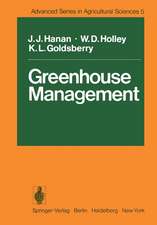Fertilization of Dryland and Irrigated Soils: Advanced Series in Agricultural Sciences, cartea 12
Autor J. Hagin, B. Tuckeren Limba Engleză Paperback – 18 noi 2011
Din seria Advanced Series in Agricultural Sciences
- 15%
 Preț: 648.89 lei
Preț: 648.89 lei - 15%
 Preț: 640.06 lei
Preț: 640.06 lei - 15%
 Preț: 645.14 lei
Preț: 645.14 lei - 15%
 Preț: 640.55 lei
Preț: 640.55 lei - 15%
 Preț: 637.93 lei
Preț: 637.93 lei - 15%
 Preț: 642.83 lei
Preț: 642.83 lei - 15%
 Preț: 641.53 lei
Preț: 641.53 lei - 15%
 Preț: 637.59 lei
Preț: 637.59 lei - 15%
 Preț: 653.46 lei
Preț: 653.46 lei - 15%
 Preț: 638.57 lei
Preț: 638.57 lei - 20%
 Preț: 546.85 lei
Preț: 546.85 lei - 15%
 Preț: 642.18 lei
Preț: 642.18 lei - 18%
 Preț: 888.49 lei
Preț: 888.49 lei - 15%
 Preț: 642.68 lei
Preț: 642.68 lei - 15%
 Preț: 643.48 lei
Preț: 643.48 lei - 15%
 Preț: 636.45 lei
Preț: 636.45 lei - 20%
 Preț: 553.61 lei
Preț: 553.61 lei - 15%
 Preț: 644.49 lei
Preț: 644.49 lei - 15%
 Preț: 656.58 lei
Preț: 656.58 lei - 18%
 Preț: 940.72 lei
Preț: 940.72 lei - 15%
 Preț: 634.00 lei
Preț: 634.00 lei -
 Preț: 382.18 lei
Preț: 382.18 lei - 18%
 Preț: 890.54 lei
Preț: 890.54 lei
Preț: 887.05 lei
Preț vechi: 1081.77 lei
-18% Nou
Puncte Express: 1331
Preț estimativ în valută:
169.76€ • 184.33$ • 142.60£
169.76€ • 184.33$ • 142.60£
Carte tipărită la comandă
Livrare economică 22 aprilie-06 mai
Preluare comenzi: 021 569.72.76
Specificații
ISBN-13: 9783642683299
ISBN-10: 3642683290
Pagini: 204
Ilustrații: VIII, 190 p.
Dimensiuni: 170 x 244 x 11 mm
Greutate: 0.33 kg
Ediția:Softcover reprint of the original 1st ed. 1982
Editura: Springer Berlin, Heidelberg
Colecția Springer
Seria Advanced Series in Agricultural Sciences
Locul publicării:Berlin, Heidelberg, Germany
ISBN-10: 3642683290
Pagini: 204
Ilustrații: VIII, 190 p.
Dimensiuni: 170 x 244 x 11 mm
Greutate: 0.33 kg
Ediția:Softcover reprint of the original 1st ed. 1982
Editura: Springer Berlin, Heidelberg
Colecția Springer
Seria Advanced Series in Agricultural Sciences
Locul publicării:Berlin, Heidelberg, Germany
Public țintă
ResearchCuprins
1 Introduction.- 1.1 Definition of Semiarid and Arid Regions.- 1.2 Major Soil Characteristics.- 1.3 Crop Production Systems.- 1.4 Irrigation.- 1.5 Changes in Fertilization Practices.- 1.6 References.- 2 Nitrogen.- 2.1 Nitrogen Fertilizers.- 2.2 Fate of Nitrogen Fertilizers in Soils.- 2.3 Crop Response to Nitrogen Fertilizers.- 2.4 Methods of Nitrogen Fertilizer Application.- 2.5 References.- 3 Phosphorus.- 3.1 Phosphate Fertilizers.- 3.2 Reactions of Phosphorus in Soils.- 3.3 Methods of Phosphate Fertilizer Application.- 3.4 Residual Effect of Phosphate Fertilizers.- 3.5 Phosphate Availability.- 3.6 Response of Crops to Phosphate Fertilization.- 3.7 References.- 4 Potassium.- 4.1 Potassium Fertilizers.- 4.2 Reactions of Potassium Fertilizers in Soil.- 4.3 Methods for Evaluation of Plant-available Potassium.- 4.4 Potassium Movement.- 4.5 Potassium Fertilization of Crops.- 4.6 References.- 5 Secondary and Micronutrients.- 5.1 The Secondary Nutrients.- 5.2 Micronutrients.- 5.3 References.- 6 Special Fertilization Practices and Multinutrient Fertilizers.- 6.1 Multinutrient Fertilizers.- 6.2 Application of Fertilizers in Irrigation Water.- 6.3 Fertilizers for Greenhouse Cultures.- 6.4 Fertilizers for Foliar Application.- 6.5 Fertilization Under Saline and Alkaline Conditions.- 6.6 References.- 7 Determining Fertilizer Requirements.- 7.1 Determination of Nutrient Availability.- 7.2 Field Experiments.- 7.3 Yield Equations.- 7.4 Estimating Economic Returns.- 7.5 Fertilizers Rates Recommendations.- 7.6 References.








